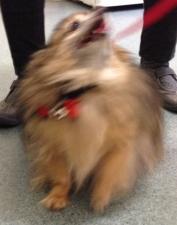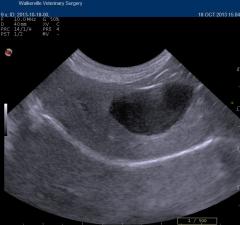Updated April 3, 2020

This is Micki. He’s so happy and active that this is the best photo we could take. But he wasn’t always so perky. Last year he started having seizures and his very concerned owner brought him to us. There was nothing remarkable found on his physical exam, so we took blood for haematology and biochemistry, as we always do when dogs are having seizures.
In this case, Micki’s blood test results showed elevations in his liver enzymes, suggesting a liver problem. To investigate the findings we scheduled an ultrasound examination of his abdomen.

An image from the scan of his liver is shown. In it, you can see from the scale markings that his liver, although unremarkable in echotexture, is only 2cm thick (the dark oval is his gall bladder) It was clearly reduced in size, and inaccessible to a biopsy needle.
Micki’s Diagnosis
We discussed the results with his owner. It was clear to us that such an abnormal liver was the source of Micki’s problems, but we cannot diagnose the exact liver condition without a biopsy. There are lots of liver problems found in dogs.
However, the problem was likely to be a degenerative hepatitis common to older dogs. You can read about the same disease in one of our vets’ dogs here.
The gradual destruction and shrinking of the liver mean it no longer has the ability to detoxify the products arriving from the gut. Therefore, these nasty compounds like ammonia and urea are shunted past the liver and manage to reach the brain. This is called hepatic encephalopathy.
Micki’s Treatment
An understandable choice was made to not proceed with an invasive liver biopsy via exploratory surgery. The treatment decision was then very clear; to provide a diet which minimised the work required to be done by the liver while at the same time supporting its ongoing survival. This food is called Hills Prescription Diet l/d.
Many owners are reluctant to make the big decision to completely change their pet’s diet in the face of illness. They probably do not think something as simple as a food can do that much to help, and worry that their pet will find the new food bland and uninteresting. However, Micki’s owner took the decision with full enthusiasm and made the difficult swap.
The results were better than even we expected. When we examined Micki recently, his owner reported that there were no more seizures in the 35 weeks since the diagnosis. Micki was brighter, more active and most surprisingly liked the food more than his old food.
Treatment of Hepatic Encephalopathy in Dogs
Treatment options include:
- liver support diets to reduce toxin production (always)
- lactulose to encourage toxin elimination (often)
- antacids to combat gastrointestinal ulcers (often)
- antibiotics to reduce toxin production (rarely)
I suspect that the liver diet is not tastier than his old food, even though it looks that way by Micki’s attitude to it. The more likely explanation is that the new food improves his brain function and sense of wellbeing so he is naturally healthier and hungrier. It’s another example of an answer we often give when an owner asks how they can stimulate their sick pet’s appetite- make them feel better!
Follow up: one year later, Micki is still going strong and is just as full of vigour and life. There is now a second liver diet called Royal Canin Hepatic Support.
Have something to add? Comments (if open) will appear within 24 hours.
By Andrew Spanner BVSc(Hons) MVetStud, a vet in Adelaide, Australia. Meet his team here.

My 11 year old labradoodle was found to have elevated ALT enzymes on routine bloodwork (311). We followed up with a bile acids test which was also elevated and an ultrasound which looked normal. He might have mild increase in thirst, but otherwise he’s asymptomatic. We were referred to an internist, who recommended either a tru-cut needle biopsy or a laparoscopic liver biopsy. Both biospy options sound risky and invasive and make me nervous. The tru cut seems less invasive but I’m concerned about bleeding and not getting enough tissue to make a diagnosis. The laparoscopy is more invasive and expensive. After reading your blog, it’s curious we were not recommended steroids or a liver supportive diet, before getting the biopsy results. By deduction, they hypothesize it could be copper storage disease. I’m struggling whether to proceed with the biopsies which seem risky, and which type of biopsy, or to go to straight to medication, support diet and supplements .
Hi Leah. I hope you’ve also seen the article where I talk about how I treated my own dog’s liver problem. I try to talk to you through the options and what might be missed at each stage. What you are being offered is the gold standard, but the tests get increasingly low yield and more invasive the further on you go. Therefore, it’s reasonable to play the odds like I did at some point and decide to treat for the most likely diagnosis, not the only one. In doing so you just need to understand what might be missed, and the possible consequences, but it’s not wrong.